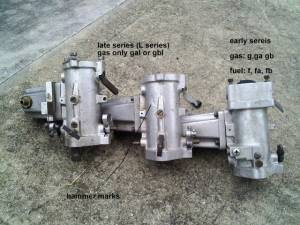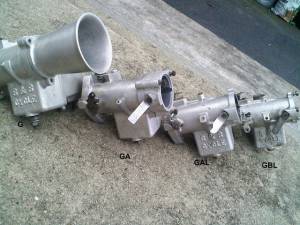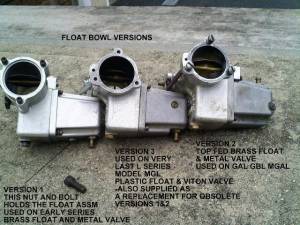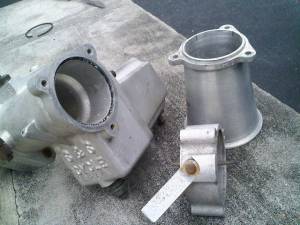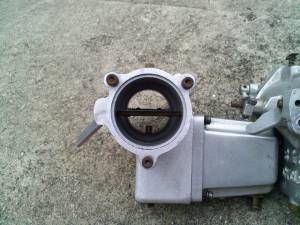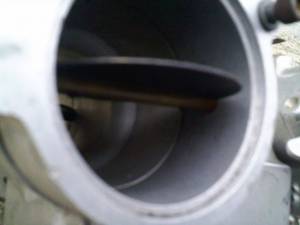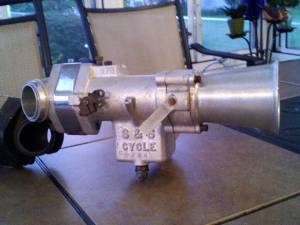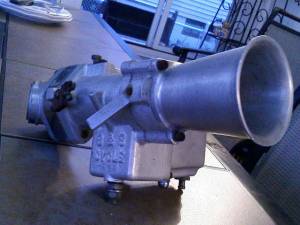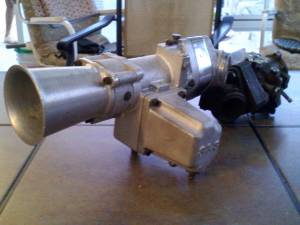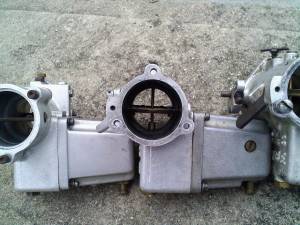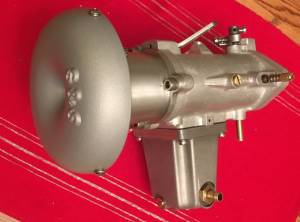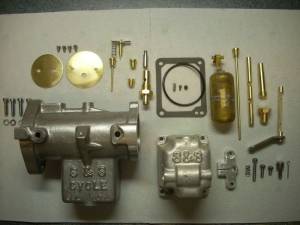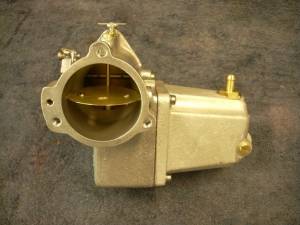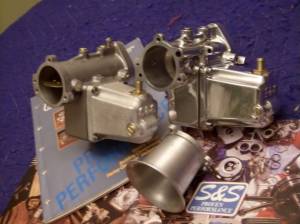Table of Contents
This is an old revision of the document!
REF: Carburetor, Intake Manifold & Exhaust - Sub-01V
S&S G, F and L Series General Information and Pics
The metering circuits of these carbs are configured for the best 1/4 mile performance. No consideration at all was given for street operation or kick starting. 1)
These were race only carbs for HD dragsters only, not for street bikes.
That didn't stop anybody from putting them on the street bikes which may be where the bad rap these carbs carry came from.
The one below has the 'street kit' that was made later to address the missing street manners.
The kit is the bolt on choke and the 1“ spacer between the carb and manifold.
After a while these 'G's were replaced by the next model (“GA” & “GB”).
They were a slightly re-metered idle/intermediate circuit to give some street-ability.
The 'GA' was identical to the 'G' except for the re-metering.
The 'GB' was a smaller throat (1-3/4” at throttle butterfly) and more importantly a smaller venturi than the 'G'-'GA' (1-7/8“ throat, 1-11/16 venturi).
The 'GA' was just passable as a street carb but it needed at least 70 ci to feed (if not it sucked).
The 'GB' actually was street-able on stock displacement bikes. It wasn't 'tame' though.
You had to cater to its narrow ''sweet spot” that changed with air temp, humidity, barometer, and most of all float level (that constantly creeped higher).
The floats & inlets were still race parts, made to be high flow at small float drops, combined with the metal to metal inlet valve, again a race thing.
The low gas consumptions of cruising on the street, barely opened the valve.
So the mile after mile of street riding vibration wore all the stuff and the float level crept higher.
So if you were OK with constant tinkering with float levels and jetting that needed to be tailored to small atmospheric changes;
(still drag race main metering circuit) you had a carb that lit your bike up like no other. A redhead girlfriend of a carb.
This amount of tinkering and the devotion it took to be on top of it was too much for all but the most race oriented owners.
So, enter the 3rd models.
The infamous 'L' series“ ('GAL' & 'GBL'). The 'L' series are great street carbs as long as the right carb went on the right bike.
These are actually totally different carbs from the predecessors as the 1st “street carbs” with real drag tendencies.
All metering circuits are made to be totally street-able as 1st consideration while leaning towards being as drag like as full street-ability will allow.
Boy did they work as intended.
But to the untrained eye, they look the same as the 1st two versions, so they get the same bad rep.
They also have the same fitments. 'GAL' needs 70” min. or they ain't street-able enough.
The 'GBL' is the product of all the previous lessons and it's unsurpassed for 900 or 1000 bikes.
So if the 'GBL' is so great how come it's so obscure? Maybe because, of the 5 versions of side bowls, S&S carbs are usually grouped as only one version.
(if you really knew there were 5 different carbs before the rare “Super A” , you are in a small group).
And 4 of the 5 work like crap on a stock street bike. So those 4 get taken off and sold a lot (adding to the rep).
The last 2 versions, the real L series units were sold from 72 to e75, and bikers being bikers, “if I'm gonna get a S&S, I'm getting the big one.
So not as many “GBL” got sold and the guys who had one didn't ever want to sell it. The one size fits all Super A & B was the response to guys buying the wrong size.
Little known fact: The venturi on a “GBL” is smaller than the venturi on a Tillotson. The Super B is the same as a Tillotson.
There are 5 different versions of this 'type' made before the Supers replaced them and 2 more versions offered in limited numbers along side the Supers. 5)
Each of the 7 were tailored to different motor sizes and applications.
Wrong one on wrong motor was/is a disaster in many areas. Throttle response is one of the problems. Although, the right carb on right motor was/is spectacular.
The 'GBL' was the only one of the 7 designed to be a street carb that would match up to the specific requirements of a stock 900.
It was also 'smallest' of the 7 and it was made side by side with the 'GAL' (biggest). Only 3 years these two models were sold (1972-74) with most being the 'GAL'.
So these carbs are rare, expensive and old and that keeps them under the radar. Many got molested in the ensuing 37 years.
But for the guy who does take the plunge and experiences the way his 900 runs with it puts the 'GBL' in the 'never sell' category.
S&S sand cast carbs were made by us and for our bikes only (made by HD nuts for HD nuts).
All the sand cast units share 3 things:
- No pump.
- The entire throat is precision machined from ac to manifold.
- They have long air column lengths with the discharge tube quite far upstream of throttle butterfly (they hit your leg).
The entire sand cast gasoline models. (may be out of order):
- G - drag only, big motors.
- GA - drag with slight mods to make 'street-able', big motor.
- GB - same but for small motors.
- GAL - street carb, big motor.
- GBL - street use, small motor.
- Super A - 1st one size fits all, street use.
- Super B - refined Super A, street use.
- MGAL GAL - reintroduced with provisions for snap throttle street, big motor.
- MGL MGAL - with super style main circuit & two jet intermediate circuit, big motor, street.
- Super D - larger Super B, giant motor claimed to be drag only but circuitry is street.
The first 3 were race only carbs. The rest were street carbs with race tendencies. Mis-application of the first 4 was very common.
G, GA, GAL, F AND FA series are all 1-7/8” butterfly. GB and FB series are both 1-3/4“. 6)
S&S G, GA, GAL
S&S GB & GBL
GB
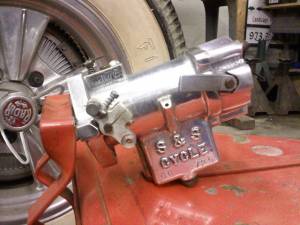 17)
17)
GBL
This carb will be fine on an 88” motor. Here's the basic stuff you need to deal with.
Manifold: use the Super B or Super E manifold.
Air Cleaner: the entire Super B setup is a bolt on to L series.
Throttle: this goes to the action cable of the 2 cable system. Forget the idle cable exists for now.
All sportsters 1972> open the throttle plate when the inner cable retreats into the outer coil.
In other words, the braided cable 'pulls' the throttle plate open. The L series (except mgl) is set up for the 1971< throttle plate actuation.
In this setup the inner cable was not braided. It was a solid wire because the inner wire pushed the throttle plate open.
You need to reverse this action at the carb.
For instance:
1st get a Super B throttle shaft and install it in the GAL. It's longer on the forward end compared to the GAL shaft.
The added length will allow you to install a second throttle lever assembly on the longer shaft. This lever is also Super B.
See the first pic below. The shaft extension will be less (but still enough) on a GAL.
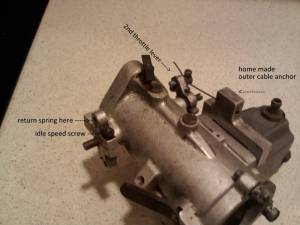 18)
18) 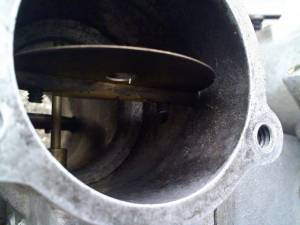 19)
19)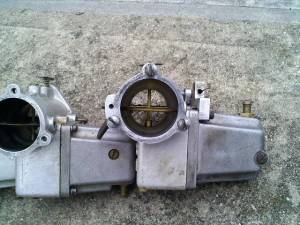 20)
20)
FB
Here's an FB converted to an FA with the popular dual float bowl conversion pioneered by Gordon Kately.
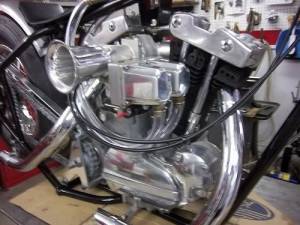 24)
24)
Mods
Here is a fabricated 2-1/4“ version of an early G style carb (L) below.
And a fabricated 2-3/8” which used a fuel pump with a Holley float bowl and accelerator pump (R).
Ten of the 2-1/4“ carbs and 25 of the 2-3/8” carbs were built. Both saw action in AMRA Pro Stock and a few of the 2-3/8“s on the streets of Houston, Tx.
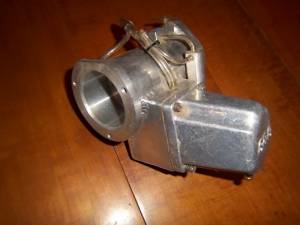 25)
25) 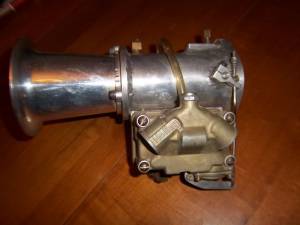 26)
26)

